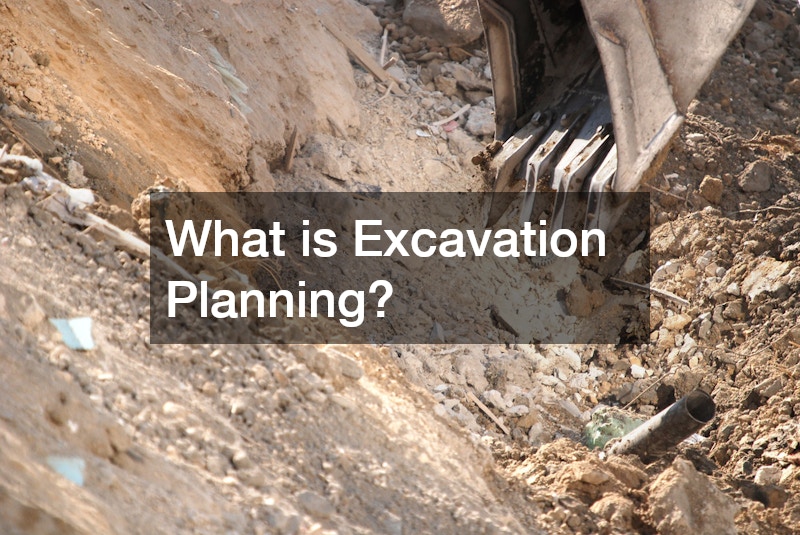Understanding the essentials of excavation planning can make your construction project smooth and efficient. This guide covers every step, from initial assessments to executing the excavation process successfully. With thorough preparation and a strong grasp of the core components, you can reduce risks, meet regulatory standards, and avoid costly delays. Whether you’re overseeing a major development or a residential renovation, comprehensive planning—including coordination with services like concrete pumping services and dumpster rental—is essential.
What is Excavation Planning?

Understanding the Definition
Excavation planning refers to the systematic approach of preparing for and carrying out the digging, grading, and movement of earth necessary for construction or development projects. It involves determining the scope, sequence, equipment, safety protocols, and regulatory requirements associated with the excavation phase. From hydro air excavation service techniques to conventional digging, methods must be chosen to suit the terrain and project type.
The Importance of Excavation Planning
Excavation is often one of the first major tasks in any construction project, setting the stage for everything that follows. Proper planning ensures structural stability, cost-efficiency, and adherence to safety standards. Without a solid plan, projects can face setbacks ranging from budget overruns to legal issues or environmental damage. This phase may also include complementary services such as utility tree services to prepare the land and address overhead or underground conflicts.
Key Components of Excavation Planning
Effective excavating planning incorporates detailed project timelines, equipment specifications, safety procedures, environmental considerations, and communication protocols. It also includes evaluating soil characteristics and mapping site logistics to ensure a smooth workflow and coordination among teams. Some projects may also integrate a deck building service to initiate the transition from groundworks to structural builds.
Challenges in Excavation Planning
Planners must contend with unpredictable soil conditions, underground utilities, varying weather patterns, and regulatory barriers. Delays can occur if the ground contains unanticipated obstacles like large rocks, high groundwater levels, or hazardous materials. Addressing these possibilities proactively helps prevent project stalls. Services like hydro air excavation service are often used in sensitive areas to mitigate risks from delicate utilities or environmentally sensitive zones.
Role in Construction Projects
Excavation lays the foundation for the rest of the construction process. Whether for residential basements, commercial footings, or large-scale infrastructure, accurate excavation planning reduces the likelihood of rework and ensures that the site meets engineering and architectural requirements. If excavation exposes hidden issues, such as failing drainage, teams may need to incorporate local crawl space repair or drainfield repair services.
Why is Site Assessment Crucial?
Identifying Potential Hazards
Site assessments identify visible and hidden dangers such as unstable slopes, sinkholes, or buried materials. Hazard recognition at the earliest stage reduces safety risks and legal liabilities, allowing for more accurate planning. Tree hazards are also considered, particularly in storm-prone areas where storm damage from fallen limbs or uprooted trees can complicate excavation.
Soil Testing and Analysis
Understanding the soil’s composition—whether sandy, clayey, or rocky—impacts the choice of machinery and excavation depth. Testing also reveals if the soil can bear structural loads or if it requires stabilization. This analysis is critical for foundation integrity, especially when services like concrete pumping services are used to pour stable and level bases.
Evaluating Site Accessibility
Ease of access determines the logistics of equipment transportation and worker mobility. Narrow entries or uneven terrain may necessitate additional planning or machinery. Planners also consider proximity to utility lines and neighboring structures. In wooded or overgrown lots, tree trimming or utility tree services may be required before work can begin.
Understanding Local Regulations
Construction sites are governed by a web of municipal, state, and federal regulations. Planners must research zoning laws, environmental protections, and safety mandates. Failing to comply can result in fines or halts in construction. For projects involving waste removal, adhering to local codes around dumpster rental and disposal is also essential.
Mapping and Surveying
Surveying the land helps define boundaries, elevations, and surface features. Accurate maps allow engineers and contractors to plan excavations that align precisely with architectural blueprints and legal property lines. In rural developments, these surveys also help locate and assess the condition of existing drainfields, supporting potential drainfield repair decisions.
How to Develop an Excavation Plan?

Setting Clear Objectives
Every successful excavation starts with defining specific goals. These might include achieving a certain depth, creating a slope, or ensuring space for utility installations. Clear objectives guide decision-making throughout the project, helping coordinate specialized services like hydro air excavation service where traditional digging may be unsuitable.
Drafting a Project Timeline
A well-structured timeline details when each phase begins and ends. It considers factors like equipment availability, permit acquisition, and weather forecasts. Staying on schedule avoids delays in subsequent construction phases, including follow-on work such as deck building service or structural installation.
Resource Allocation
Effective resource allocation involves assigning the right number of workers, equipment, and budget. Overcommitting or underestimating resources can lead to inefficiencies or budget constraints. Flexibility must be built in to adapt to surprises. This planning also includes coordination with vendors for equipment like concrete pumping services or services like dumpster rental.
Risk Management Strategies
Identifying risks such as equipment failure, worker injury, or weather disruptions allows teams to develop contingency plans. Risk management includes insurance coverage, backup suppliers, and safety drills. Anticipating storm damage, for example, allows teams to act swiftly in severe weather events.
Plan Review and Approval
Before breaking ground, the excavation plan undergoes review by project stakeholders and regulatory bodies. Approval ensures that the plan aligns with safety laws, environmental guidelines, and contractual obligations. A thorough review can prevent rework, especially in complex projects involving local crawl space repair or utility tree services.
What Equipment is Needed for Excavation?
Overview of Essential Machinery
Excavation projects typically use excavators, backhoes, bulldozers, and skid-steer loaders. Each serves a unique function, from digging and trenching to grading and hauling materials. For specialized situations, hydro air excavation service machinery is deployed to avoid damage to sensitive subsurface elements.
Understanding Equipment Functions
Excavators handle deep digging and heavy lifting, while bulldozers level surfaces and push soil. Trenchers create narrow ditches for pipes or cables. Loaders transport materials across the site. Operators must match machinery to tasks for optimal results, especially when integrated with systems like concrete pumping services.
Equipment Safety Checks
Before use, all machines require thorough inspections. This includes checking fluid levels, hydraulics, tire pressure, and operational controls. Malfunctioning equipment poses significant risks to personnel and timelines, and can be particularly hazardous in wooded lots where tree trimming is underway.
Hiring vs. Purchasing Equipment
Project scope and duration influence whether companies buy or rent equipment. Rentals offer flexibility and reduced maintenance costs, whereas purchasing may be economical for long-term or repeated use. For excavation teams handling multiple projects that also require services like dumpster rental, renting may simplify logistics.
Maintenance Considerations
Ongoing maintenance includes daily checks, scheduled servicing, and prompt repairs. Proper upkeep extends machinery lifespan, ensures reliability, and meets warranty requirements. Maintenance is especially critical in mixed-use excavation projects that require hydro air excavation service, concrete pumping, or drainage work.
How to Ensure Safety in Excavation?
Training and Certification Requirements
All personnel must receive training on equipment operation, hazard recognition, and emergency response. Certification ensures they meet regulatory standards and know how to act in high-risk scenarios, including those involving storm damage response or drainfield repair.
Implementing Safety Protocols
Safety procedures include shoring for trench stability, signage to warn of deep holes, and protocols for working near utilities. PPE—like helmets, gloves, and boots—is mandatory. Checklists and briefings reinforce awareness and often incorporate tree trimming safety when trees must be cleared before digging.
Emergency Response Preparedness
Excavation sites must have clear evacuation routes, first aid stations, and contact information for emergency services. Teams practice drills to prepare for scenarios like cave-ins or equipment fires. Storm damage is another scenario requiring a detailed response plan.
Monitoring and Auditing Safety Compliance
Safety officers or supervisors conduct regular audits and site inspections. These reviews identify non-compliance issues and prompt corrective actions. Documentation of inspections is essential for liability and future reference, especially when working near utility lines or during services like local crawl space repair.
Case Studies of Effective Safety Practices
Successful projects often showcase the importance of rigorous safety planning. In one urban project, proactive gas line identification and reinforced trench supports prevented a major accident. Similarly, teams managing storm damage debris used utility tree services to safely remove risks before excavation.
What Permits are Required for Excavation Projects?

Understanding Permit Types
Permits vary by location and project type. Common types include grading permits, environmental permits, and utility clearance approvals. Each is designed to ensure public and environmental safety and may tie into services like deck building service and local crawl space repair.
Application Procedures
Permit applications require site plans, project descriptions, and environmental impact statements. Submissions are reviewed by government agencies and sometimes involve public hearings or consultations. Accurate representation of all services, including hydro air excavation service or concrete pumping, is necessary.
Timelines for Permit Approval
Approval times range from a few days to several months, depending on project complexity and local bureaucracies. Planners should incorporate this timeline into their overall schedule to prevent delays that could affect related services such as dumpster rental or drainfield repair.
Common Regulatory Challenges
Projects often face challenges like overlapping jurisdictions, incomplete documentation, or objections from neighboring landowners. Proactive communication and thorough paperwork reduce the risk of permit denial. In tree-heavy sites, acquiring permissions for tree trimming or removal may delay excavation.
Post-Approval Requirements
Even after approval, projects must comply with ongoing regulations. Inspectors may visit the site to ensure adherence. Non-compliance can result in penalties or work stoppages, particularly in environmental zones where storm damage or erosion must be controlled.
How to Handle Unexpected Challenges?
Identifying Unexpected Challenges
Despite thorough planning, surprises such as unmarked utility lines, sudden storms, or equipment failure can disrupt excavation. Rapid identification minimizes the impact on the project and allows quick activation of services like hydro air excavation or utility tree services.
Contingency Planning
Contingency plans allocate backup resources and alternative solutions. For instance, if a trench floods, pumps and protective coverings should already be on hand. The goal is rapid problem-solving without derailing the timeline or affecting interconnected services like deck building service.
Effective Communication Strategies
A strong communication framework ensures that all stakeholders are informed promptly. This includes team members, supervisors, and external partners. Using digital platforms for real-time updates streamlines collaboration and avoids miscommunication across teams managing services from concrete pumping to drainfield repair.
Resource Reallocation
Unexpected issues might require diverting workers, extending shifts, or acquiring different equipment. Flexibility in labor and machinery use allows the project to stay on track despite changes. If storm damage occurs, services like tree trimming and emergency dumpster rental may need to be fast-tracked.
Case Studies of Problem Solving
In one case, a suburban excavation encountered an uncharted water main. Rather than halt the entire project, the team rerouted work to another section while utility crews resolved the issue, keeping delays minimal. Having hydro air excavation service on standby helped excavate around the issue without damage.
What is the Role of Technology in Excavation?
Overview of Technological Advances
Modern excavation projects benefit from a range of innovations. These include 3D modeling, autonomous machinery, and integrated project management platforms. These technologies are useful in coordinating everything from hydro air excavation to local crawl space repair.
Using Drones for Surveying
Drones offer fast, accurate topographic surveys and real-time progress tracking. They reduce the time needed for mapping and can access hard-to-reach or hazardous areas safely, such as in tree-heavy lots requiring utility tree services.
Software Solutions for Planning
Project management software allows for detailed planning, task assignment, and resource tracking. It also facilitates permit management, cost estimation, and real-time collaboration across teams coordinating services such as concrete pumping and dumpster rental.
GPS and Laser Guidance Systems
Advanced machinery equipped with GPS and laser systems can perform precise digging with minimal manual input. These tools reduce human error and enhance operational speed and accuracy, particularly in complex residential settings requiring local crawl space repair or drainfield repair.
Benefits of Automation
Automated equipment minimizes labor requirements and increases safety by keeping workers out of danger zones. It also allows for 24/7 operation with minimal fatigue, boosting overall productivity across services from excavation to deck building.
How to Plan for Environmental Protection?

Understanding Environmental Regulations
Excavation often affects ecosystems, water tables, and air quality. Compliance with environmental regulations is non-negotiable and includes restrictions on emissions, dust, and site runoff. Projects involving hydro air excavation service can minimize environmental disruption.
Land Restoration Techniques
After excavation, sites must be stabilized to prevent erosion or degradation. Restoration may involve replanting vegetation, reinforcing slopes, or installing drainage systems. Areas damaged by storm damage may require tree trimming and debris removal as part of restoration.
Waste Management Practices
Excavation generates debris such as rocks, soil, and old infrastructure. Waste must be sorted, reused when possible, and disposed of responsibly. Coordinating with a reliable dumpster rental provider ensures efficient and compliant waste handling.
Water Preservation Strategies
Excavation near water bodies requires careful management to avoid contamination. Barriers, drainage controls, and sediment filters protect nearby waterways and groundwater, especially in areas where drainfield repair is required.
Impact Assessments and Mitigation
Before starting, impact assessments evaluate potential harm to the environment. Mitigation strategies then minimize damage through thoughtful planning and adaptive techniques. Services like hydro air excavation support low-impact excavation in sensitive areas.
How to Ensure Successful Project Completion?
Post-Excavation Procedures
Finishing the excavation involves stabilizing slopes, compacting soil, and preparing the site for the next phase of construction. Inspections confirm the work meets engineering standards and supports follow-up phases like deck building service.
Evaluating Project Outcomes
Project managers conduct a thorough evaluation of performance metrics, budget adherence, and timeline accuracy. This analysis informs stakeholders and future project planning and can highlight effective integration of services like concrete pumping and drainfield repair.
Feedback and Reporting Mechanisms
Post-project debriefs gather input from crew members, contractors, and clients. Reports document what went well and what could improve, ensuring organizational learning, especially in projects that combined excavation with local crawl space repair or utility tree services.
Documenting Lessons Learned
A dedicated review captures lessons for future reference. This includes handling of unforeseen challenges, supplier performance, and effectiveness of safety protocols across all service lines.
Continual Improvement Strategies
Ongoing improvement comes from revisiting planning processes, upgrading equipment, and investing in team training. A culture of refinement ensures better outcomes over time, from excavation to final site development.
Effective excavation planning is the cornerstone of a successful construction project. By focusing on thorough planning, safe practices, and adaptation to challenges, your excavation project can achieve its desired outcomes smoothly and efficiently. Incorporating essential services—from hydro air excavation to dumpster rental and deck building—enhances both execution and final results. With the right strategy, tools, and team, your next excavation project can lay the perfect foundation for long-term success.